TITLE 312 NATURAL RESOURCES COMMISSION
Final Rule
LSA Document #21-451(F)
DIGEST
Amends
312 IAC 5-3.5-1 governing the administration of licenses for fishing tournaments. Amends
312 IAC 9-3-18 governing the use of body-gripping traps. Amends
312 IAC 9-10-11 governing the use of body-gripping traps under nuisance wild animal control permits. Adds
312 IAC 9-10-27 governing the indication of being an organ donor when purchasing a hunting, fishing, or trapping license online. Effective 30 days after filing with the Publisher.
Authority:
IC 14-10-2-4;
IC 14-15-7-3
Sec. 1. (a) This rule applies to both of the following:
(1) The process for designating any public water where organized activities and fishing tournaments are regulated.
(2) The administration of organized activities and fishing tournaments on waters designated under subdivision (1).
(b) Exempted from this rule are each of the following:
(1) A boat race.
(2) A water ski event.
(3) A major organized boating activity.
(c) A person must not conduct or participate in a fishing tournament or other organized activity on a public water designated in this rule except under a license issued under this rule.
(d) The department's division of law enforcement shall administer this rule.
(Natural Resources Commission; 312 IAC 5-3.5-1; filed Aug 27, 2015, 10:40 a.m.: 20150923-IR-312140515FRA; readopted filed Sep 16, 2020, 8:15 a.m.: 20201014-IR-312200355RFA; filed May 5, 2022, 9:03 a.m.: 20220601-IR-312210451FRA)
312 IAC 9-3-18 Prohibited methods of pursuit and taking wild animals; exceptions
Authority:
IC 14-10-2-4;
IC 14-22-2-6
Sec. 18. (a) A person must not take a wild animal with a foot-hold trap possessing saw-toothed or spiked jaws.
(b) A person must not take a wild animal with a foot-hold trap if the widest inside jaw spread perpendicular to the trap's baseplate (Figure 1) is greater than or equal to five and three-quarters (5 3/4) inches and the inside width between the trap's hinge posts (Figure 2) is greater than or equal to five and three-quarters (5 3/4) inches unless the jaws of the trap have at least a one-eighth (1/8) inch offset (Figure 3), the gap of the offset is filled with securely attached rubber pads, or the trap is completely covered by water. The hinge posts must be maintained at a ninety (90) degree angle to the trap's baseplate (Figures 4 and 5).
(c) A person must not take a wild animal with a foot-hold trap set on land if the inside jaw spread perpendicular to the trap's baseplate is greater than six and one-half (6 1/2) inches and the inside width between the trap's hinge posts is greater than six and one-half (6 1/2) inches.
(d) Notwithstanding subsection (b), a person may use species-specific foot-hold traps (Figure 6) that enclose the captured animal's foot, such as The EGG Trap™, Lil' Grizz Get'rz™, Duffer's Raccoon Trap™, Coon Cuffs™, and similar traps.
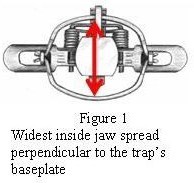
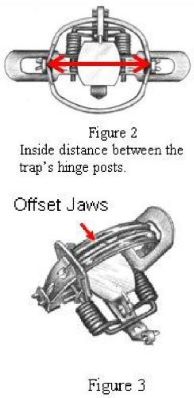
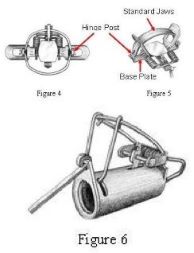
(e) As used in this section, "offset jaws" means the jaws of a leg-hold trap in which the holding area of the jaws is separated by a gap or offset (specified measurement) when the trap is closed (not in the set position). The gap or offset must extend at least eighty percent (80%) of the holding area of the trap's jaws.
(f) A person must not take a wild animal with a Conibear™, Dahlgren™, Bigelow™, or similar body-gripping trap if the widest vertical inside jaw spread measured at the horizontal center of the trap's jaws and the widest horizontal inside jaw spread measured at the vertical center of the trap's jaws is either of the following:
(1) Larger than seven and one-half (7 1/2) inches if square. or
(2) Larger than eight (8) inches, if round.
Otherwise, the trap must be completely covered by when set, at least fifty percent (50%) of the opening of the trap must be submerged in water.
(g) A person must not use a snare to trap a wild animal except upon land owned by the user or with the written permission of the landowner. No snare shall be used that permits a circumference greater than fifteen (15) inches unless:
(1) at least fifty percent (50%) of the loop of the snare is covered by water; or
(2) the snare employs a relaxing snare lock (a lock that will allow the snare's loop size to increase once pulling tension is no longer exerted along the snare from its anchored end).
(h) A person must not disturb the den or house of a wild animal:
(1) by shooting, digging, cutting, or chipping into the:
(A) leaf nest;
(B) hole;
(C) burrow;
(D) tree;
(E) cavity;
(F) pocket; or
(G) den; or
(2) with:
(A) the aid of:
(i) smoke;
(ii) fire;
(iii) fumes;
(iv) chemicals;
(v) a ferret; or
(vi) another small animal; or
(B) any mechanical device, other than a trap set lawfully, introduced into the:
(i) hole;
(ii) burrow;
(iii) tree; or
(iv) den;
where the animal is hidden or sheltered.
(i) A person must not wear or use a device to climb poles or trees for the purpose of dislodging a wild animal from a location:
(1) where the animal has secreted itself for security or protection; or
(2) in which the animal maintains a nest or den.
(j) A person must not possess an ax, a saw, or a device to climb poles or trees while in the field or woods at night for the purpose of dislodging a wild animal from a location:
(1) where the animal has secreted itself for security or protection; or
(2) in which the animal maintains a nest or den.
(k) A person must not chase or take a furbearing mammal between sundown and sunrise without carrying a continuous shining light that is visible for at least five hundred (500) feet.
(l) A person must not hunt a furbearing mammal from a boat.
(Natural Resources Commission; 312 IAC 9-3-18; filed May 12, 1997, 10:00 a.m.: 20 IR 2708; readopted filed Jul 28, 2003, 12:00 p.m.: 27 IR 286; filed Apr 4, 2008, 2:56 p.m.: 20080430-IR-312070659FRA; readopted filed Nov 24, 2008, 11:08 a.m.: 20081210-IR-312080672RFA; readopted filed May 20, 2014, 9:43 a.m.: 20140618-IR-312140017RFA; readopted filed Sep 18, 2019, 1:16 p.m.: 20191016-IR-312190325RFA; filed May 5, 2022, 9:03 a.m.: 20220601-IR-312210451FRA)
312 IAC 9-10-11 Nuisance wild animal control permit
Authority:
IC 14-10-2-4;
IC 14-22-2-6
Sec. 11. (a) The director may, without fee, issue a temporary permit to control a nuisance wild animal that is:
(1) causing damage or threatening to cause damage to property; or
(2) posing a health or safety threat to persons or domestic animals.
If it is a black bear, there must be a known (confirmed), immediate safety risk to persons or domestic animals. The method and dates of control and disposition of the animal shall be set forth in the permit.
(b) A live wild animal taken under this section shall not be:
(1) possessed for more than forty-eight (48) hours;
(2) sold;
(3) traded;
(4) bartered; or
(5) gifted.
(c) A property owner or lessee may obtain a permit under this section for the control of a nuisance wild animal.
(d) A person who charges a fee or provides a service to the public for nuisance wild animal control services must obtain a permit under this subsection to assist a property owner or lessee with the control of a nuisance wild animal. The following testing requirements apply:
(1) A permit applicant must correctly answer at least eighty percent (80%) of the questions on a written examination of basic knowledge supervised and administered by the division of fish and wildlife.
(2) A permittee who has satisfied subdivision (1) must, within four (4) years of being issued the permit and every four (4) years thereafter, either:
(A) satisfy the same requirements as are set forth in subdivision (1) on another examination; or
(B) complete sixteen (16) hours of continuing education as approved by the division.
(3) A person who fails an examination under this section may retake the examination one (1) additional time within forty-five (45) days, but not again within one hundred eighty (180) days after a second failure.
(4) A person who has had a permit under this section for twenty-five (25) years is exempt from the requirements in subdivision (2).
(e) An application for a nuisance wild animal control permit must be completed on a departmental form and filed with the division of fish and wildlife.
(f) An individual who does not hold a permit under subsection (d) may assist a permittee, but only if the permittee directly supervises or coordinates the activities of the unpermitted person. A copy of the permit must be on the person when conducting any authorized activities.
(g) A captive animal must be properly handled in an expeditious manner to prevent unnecessary physical injury.
(h) The following methods may be used to take a wild animal under this section:
(1) Firearms, if possessed and used in compliance with all applicable state, local, and federal firearm laws.
(2) Steel and live traps, except as follows:
(A) A foothold trap that possesses saw-toothed or spiked jaws.
(B) A foothold trap that:
(i) has the widest inside jaw spread perpendicular to the trap's baseplate (Figure 1) greater than or equal to five and three-quarters (5 3/4) inches and the inside width between the trap's hinge posts (Figure 2) greater than or equal to five and three-quarters (5 3/4) inches unless the jaws of the trap have at least a one-eighth (1/8) inch offset (Figure 3), the gap of the offset is filled with securely attached rubber pads, or the trap is completely covered by water. The hinge posts must be maintained at a ninety (90) degree angle to the trap's baseplate (Figures 4 and 5); and
(ii) has an inside jaw spread perpendicular to the trap's baseplate greater than six and one-half (6 1/2) inches and the inside width between the trap's hinge posts greater than six and one-half (6 1/2) inches and set on land.
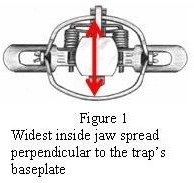
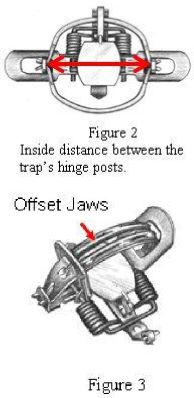
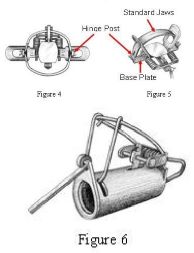
(C) A Conibear™, Dahlgren™, Bigelow™, or similar body-gripping trap that has the widest vertical inside jaw spread measured at the horizontal center of the trap's jaws and the widest horizontal inside jaw spread measured at the vertical center of the trap's jaws is larger than eight (8) inches unless the trap is completely covered by at least fifty percent (50%) of the opening of the trap when set is submerged in water.
(D) As used in this subsection, "offset jaws" means the jaws of a leg-hold trap in which the holding area of the jaws is separated by a gap or offset (specified measurement) when the trap is closed (not in the set position). The gap or offset must extend at least eighty percent (80%) of the holding area of the trap's jaws.
(3) Snares with a circumference not greater than fifteen (15) inches unless:
(A) at least fifty percent (50%) of the loop of the snare is covered by water; or
(B) the snare employs a relaxing snare lock (a lock that will allow the snare's loop size to increase once pulling tension is no longer exerted along the snare from its anchored end).
(4) Any other methods specified by the permit.
(i) All traps, including snares, must be checked at least once every twenty-four (24) hours, and any animal caught in a trap or snare must be removed from that trap or snare within twelve (12) hours from notice to the permit holder of an animal caught in the trap or snare.
(j) The following restrictions apply to the treatment of an animal captured live under this permit:
(1) When on-site release is not the best viable option, the animal must be:
(A) released in the county of capture with prior consent from the landowner or landowner's agent;
(B) euthanized; or
(C) treated as otherwise authorized in the permit.
(2) An animal must be euthanized with the:
(A) safest;
(B) quickest; and
(C) most painless;
available method as recommended and approved by the division of fish and wildlife.
(3) Prior consent is required from the:
(A) landowner; or
(B) landowner's agent;
before an animal is released on any property.
(4) Notwithstanding subdivision (1), an attempt must be made to first capture and relocate an endangered species into the appropriate habitat. If not feasible or possible, then an endangered species may be euthanized only with written authorization by the division of fish and wildlife.
(5) The carcass of a bear taken under this permit must be given to the department within seven (7) business days of taking the bear.
(6) A permit holder must notify the division of fish and wildlife within twenty-four (24) hours of the taking of more than five (5) individual bats from any one (1) site/structure from June 1 through July 31.
(k) A permit expires on December 31 of the year the permit is issued. The permittee must maintain a current record to include the following:
(1) The name and address of the landowner assisted.
(2) The date assistance was provided.
(3) The number and species of animals affected.
(4) The method of disposition.
(5) The name and address of the landowner where each animal was released (if applicable).
A copy of the records shall be kept on the premises of the permittee for at least two (2) years after the transaction and must be presented to a conservation officer upon request.
(l) A permittee must file an application by January 31 of each year in order to renew a permit. The annual report required under subsection (m) must accompany the renewal application.
(m) The permit holder shall provide an annual report to the division by January 31 of each year. The report shall list the following:
(1) The:
(A) number; and
(B) species;
of animals taken.
(2) The county where the animal was captured.
(3) The method of disposition.
(4) The name and address of the landowner, including county, where each animal was released (if applicable).
(n) A permit issued under this section may be suspended or revoked if the permittee does the following:
(1) Fails to comply with any of the following:
(B) This article.
(C) A term of the permit.
(2) Provides false information to obtain a permit under this section.
(3) Uses or employs any:
(A) deception;
(B) false pretense; or
(C) false promise;
to cause a consumer to enter into an agreement for the removal of a nuisance wild animal.
(o) No permit shall be issued under this section:
(1) for the control of a migratory bird, except a mute swan; or
(2) if granting the permit would violate a federal law.
(p) Except as authorized in subsection (q), the hide, carcass, or other part or portion of a wild animal taken under this section shall not be:
(1) sold;
(2) traded;
(3) bartered; or
(4) gifted, except if gifted with no compensation of any kind to:
(A) an accredited scientific or educational institution with a special purpose salvage permit issued under section 13.5 of this rule; or
(B) the department;
if tagged with the permit holder's name and address, signature of the person who took the animal, and date the animal was taken.
(q) The meat of a wild animal taken under this section may be retained or gifted to another person for personal consumption if tagged with the permit holder's name and address, signature of the person who took the animal, and date the animal was taken.
(r) A permit holder must obtain permission from the landowner or tenant prior to setting a trap, snare, or other device or capturing a wild animal on that landowner or tenant's property.
(s) A conservation officer may inspect the equipment, wild animals, and any records relative to a permit issued under this section at any reasonable hour.
(Natural Resources Commission; 312 IAC 9-10-11; filed May 12, 1997, 10:00 a.m.: 20 IR 2732; filed Oct 28, 2002, 12:03 p.m.: 26 IR 692; readopted filed Jul 28, 2003, 12:00 p.m.: 27 IR 286; filed Jun 23, 2006, 2:24 p.m.: 20060719-IR-312050214FRA; filed Apr 4, 2008, 2:56 p.m.: 20080430-IR-312070659FRA; readopted filed Nov 24, 2008, 11:08 a.m.: 20081210-IR-312080672RFA; filed Feb 28, 2014, 8:01 a.m.: 20140326-IR-312130024FRA; readopted filed May 20, 2014, 9:43 a.m.: 20140618-IR-312140017RFA; filed Sep 23, 2015, 9:57 a.m.: 20151021-IR-312140477FRA; filed Jun 21, 2018, 1:45 p.m.: 20180718-IR-312170436FRA; readopted filed Sep 18, 2019, 1:16 p.m.: 20191016-IR-312190325RFA; filed Nov 16, 2020, 9:30 a.m.: 20201216-IR-312200069FRA; filed May 5, 2022, 9:03 a.m.: 20220601-IR-312210451FRA)
312 IAC 9-10-27 Indication of anatomical gift when purchasing a hunting, fishing, or trapping license
Authority:
IC 14-10-2-4;
IC 14-22-11-20
Sec. 27. (a) An individual eighteen (18) years of age or older may indicate an intention to make an anatomical gift by authorizing a symbol to be imprinted on a resident hunting, fishing, or trapping license if the license is purchased through the department's online license system.
(b) An individual must execute a signed affidavit and submit it to the department to be removed from the department's license system and have the symbol indicating the donation of an anatomical gift removed from a hunting, fishing, or trapping license.
(Natural Resources Commission; 312 IAC 9-10-27; filed May 5, 2022, 9:03 a.m.: 20220601-IR-312210451FRA)
Hearing Held: January 20, 2022
Approved by Attorney General: April 28, 2022
Approved by Governor: May 3, 2022
Filed with Publisher: May 5, 2022, 9:03 a.m.
Documents Incorporated by Reference: None Received by Publisher
Small Business Regulatory Coordinator: Linnea Petercheff, Licensing and Permit Supervisor, Division of Fish and Wildlife, Department of Natural Resources, 402 West Washington Street, Room W273, Indianapolis, IN 46204, (317) 233-6527, lpetercheff@dnr.in.gov
Posted: 06/01/2022 by Legislative Services Agency
DIN: 20220601-IR-312210451FRA
Composed: Apr 19,2024 1:18:08PM EDT
A
PDF version of this document.

